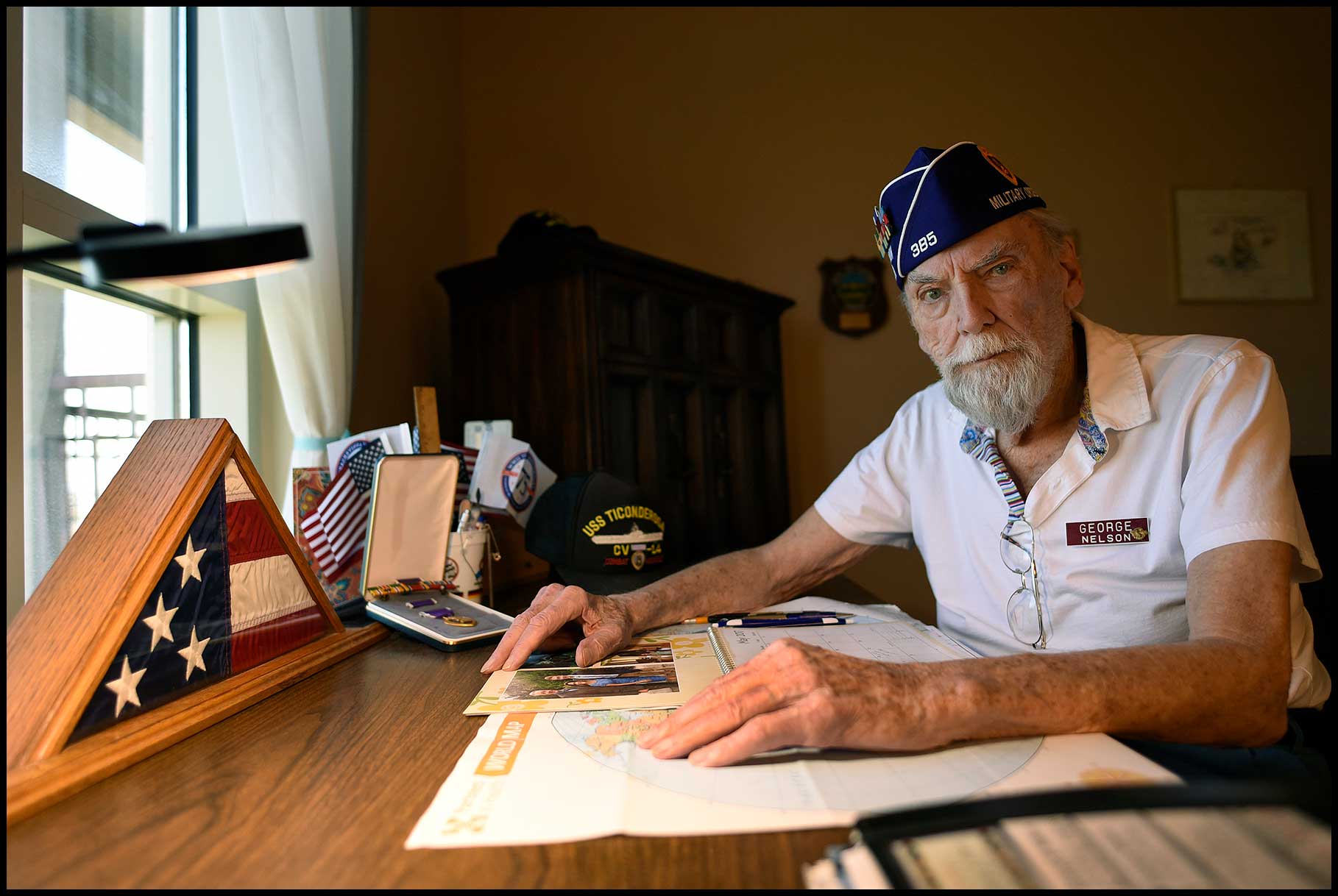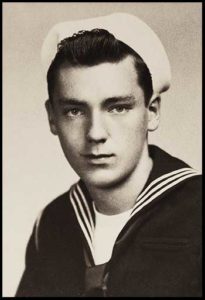
George Nelson
Stationed on
USS Ticonderoga
George Nelson
Fireman 1st Class, U.S. Navy
1944–1945
Seaman George Nelson
San Diego, CA, 1944I was on the deck with the damage control officer when the last suicide plane came in. He hit the main director over the bridge and the bombs came off, went over our heads and exploded in the middle of the flight deck. When I came to, my leg was on my face.
I was born in 1927 and raised in Philadelphia during the Depression. My sister and I were in an orphanage. When the war came along, we were adopted. My dad, who adopted us, had a good job as a stationary engineer when he was drafted. He was 35 years old when he joined the Seabees.
I went in the Navy in May, 1944 at 17. My dad was a Chief in the Navy and that helped make up my mind. I went to boot camp in Camp Peary, Virginia. In August I went aboard the Ticonderoga. They sent us to fire school in Pearl Harbor for fighting fires aboard ships. We then went to Ulithi Atoll. From there we joined Task Force 38 with Halsey. We were one of 11 carriers. It was the second battle of the Philippines with major strikes against Leyte, Luzon, Mindanao, and Formosa. The Japanese had just started their suicide planes. It was opening our eyes to combat.
The day we got hit, January 21, 1945, I remember a general quarters alarm going off about four times, and then the explosion. The suicide plane followed our planes, came in like he was landing and slid and dropped down the forward elevator. The whole hangar deck went up and 80-some planes were on fire. We opened up fire extinguishers and threw them down to the hangar deck to eat up the oxygen.
I was on the deck with the damage control officer when the last suicide plane came in. He hit the main director over the bridge and the bombs came off, went over our heads and exploded in the middle of the flight deck. When I came to, my leg was on my face. I grabbed the officer beside me for help and he was dead. I just screamed. I tell people when you are young, nobody should see combat more than once. Once is enough. I was never scared as long as I could run and see. But when I came to on that deck, I couldn’t run. I was scared, and the fear never left me until I eventually wound up in San Francisco.
We met up with a hospital ship and a doctor from the Mayo Clinic did the surgery. I had an inch and a half of femur missing, but they could do a bone graft and were able to save my leg. I was flown up to Guadalcanal to a major hospital there for the final surgery. A couple of days later I woke up, and the guy in the next bed looked too old to be in the service. The guys that were coming in were from Iwo Jima. He said he was a Seabee. I said, ‘My dad’s a Seabee, 71st Battalion.’ He said they were a half a mile down the road. I told the doctor that I just heard my dad was here and could we let him know somehow. ‘Tell him you have a surprise for him,’ I said. ‘He doesn’t know I am in the Navy.’
I’d been writing letters to Mom like I was in high school running cross country. and how my marks were bad. Then she would send them to Dad from the house. He used to tell my mother, ‘Don’t let that kid get in the service; that’s why I’m going.’ I hadn’t seen him in almost three years. He looked at me in that body cast and said, ‘What the hell are you doing here?’
Every day Dad would come for lunch. I didn’t know if he came for me or the food. I went home to the hospital in Fort Smith, Virginia until the war ended. I was discharged on August 15, 1945. When I left the Navy I went to LaSalle in Philadelphia—the physics program; majored in electronics. I went to school at night, because I had a family.
I have been in the drone program for 42 years developing pilotless aircraft. We flew out of the Naval Air Development Center in Pennsylvania. I worked for the Navy as a civilian. I loved it. We should never have manned aircraft again. {05-24-2017 • San Antonio, TX}
